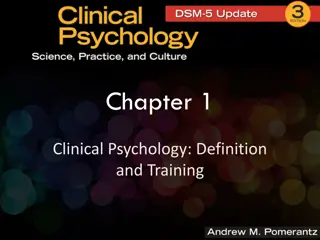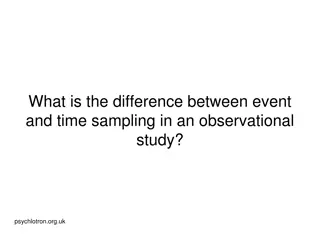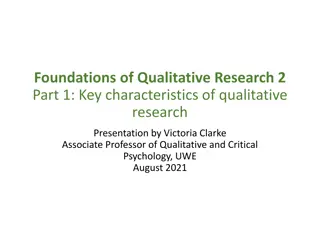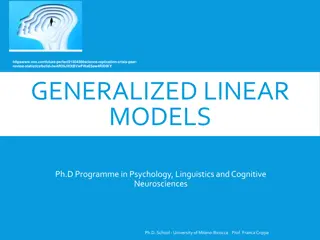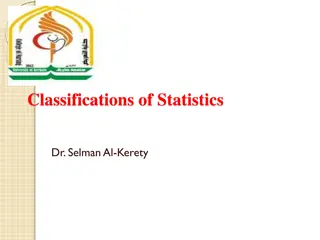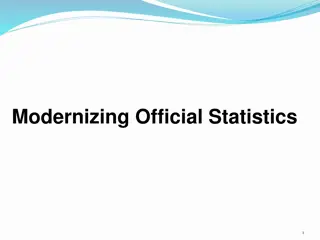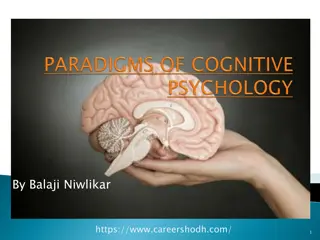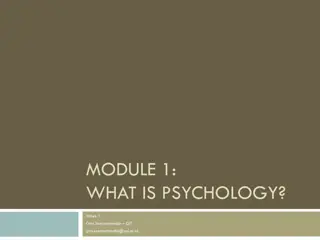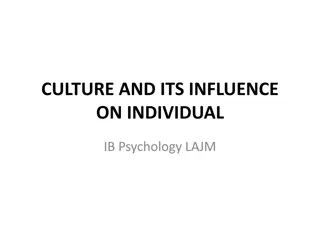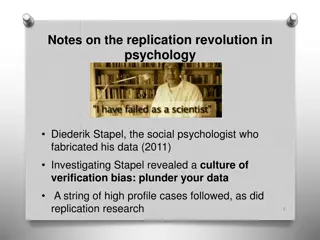Applied Statistics in Psychology: Bridging Theory and Research
This course focuses on teaching applied statistics in psychology, with an emphasis on inferential statistics such as t-tests, ANOVA, correlation, regression, and chi-square. Real-world examples, diversity research, and connections to research methodology are highlighted throughout the course to enhance conceptual understanding and practical application of statistical tests. Students will learn to formulate hypotheses, conduct statistical analyses, interpret results, and apply findings to real-world scenarios.
- Statistics in Psychology
- Applied Approach
- Inferential Statistics
- Research Methodology
- Diversity Research
Download Presentation

Please find below an Image/Link to download the presentation.
The content on the website is provided AS IS for your information and personal use only. It may not be sold, licensed, or shared on other websites without obtaining consent from the author. Download presentation by click this link. If you encounter any issues during the download, it is possible that the publisher has removed the file from their server.
E N D
Presentation Transcript
Chapter ?: Introduction Statistics in Psychology
Learning Objectives Focus on conceptual understanding Use technology to explore concepts and analyze data Statistical Tests and related concepts Teach statistical thinking Students will be able to state the null and alternative hypotheses for statistical tests. Students will understand the appropriate use of statistical tests. Students will know how to accurately write the results of a statistical test in APA format. Students will know how to calculate the results of statistical tests utilizing a mixture of hand calculations and statistical software programs. Students will know how to interpret the results of statistical tests. Students will be able to translate the results of said statistical test into real world meaning. Students will know how to test that the dataset meets the assumptions needed to run statistical tests. Students will know how to run statistical tests in JASP. Students will be familiar with the following statistical tests: Descriptive statistics: mean, standard deviations NHST add-ons: effect size, confidence intervals Z-scores and tests T-tests: single, independent, and paired samples ANOVA: one-way and two- factor Correlation Regression Chi-square
Welcome! This course takes an applied approach to teaching statistics Inferential Statistics (i.e., t tests, ANOVA, correlation, regression, chi-square) will highlight different areas of diversity research Serves as a framing device for the learning and application of the different statistical concepts covered Reasons for this approach: 1. Provides real examples of research that demonstrate the application of the statistical concept highlighted 2. Introduction to the way researchers discuss and present statistics in peer- reviewed journals 3. Helps bridge the gap between statistics and research methodology
Connecting Statistics and Research Methodology/Design Examples come from real published data and demonstrate researchers using each statistical test covered in real life Each example outlines: Why chosen statistical test was most appropriate to answer the research question Research question Research design Assignments use real data from human participants to practice statistical analyses
Diversity is a major area of psychological research itself, but also affects the work done in almost every sub-discipline of psychology Why should psychological science care about diversity? The APA s Ethical Principles of Psychologists and Code of Conduct calls on us to be knowledgeable about diversity in order to avoid biases and prejudices not an easy task The research examples in the manual illustrate our course concepts AND help us understand diversity
Why should psychological science care about diversity? It s about good science. (Sellers, 2015) Scientists are trained to work objectively but they are still human Complete objectivity when examining and trying to explain human behavior may not be possible
Did you know? In a 2010 review of Behavior and Brain Sciences, 95% of studies used college students (Henrich, Heine & Norenzayan, 2010).
What else has biased our understanding of psychology? Lack of early representation and opportunities for women and people of Color Inability to obtain degrees (Mary Whiton Calkins, 1stwoman APA president, never granted degree by Harvard) Barred from scientific circles and organizations (e.g., Titchener barred women from Experimentalists, a group formed in 1904) Men took credit for women s work (i.e., Matilda Effect) Georg M ller reinvented Mary Whiton Calkins groundbreaking paired-associations method Impacted what research questions were asked and how they were interpreted for centuries
Age & Generation Developmental Disability ADDRESSING Model of Diversity (Hays, 1996, 2008) Disability (Acquired) Religion Ethnicity & Race Socioeconomic status Sexual orientation Indigenous Group National Origin & Language Gender
The Backfire Effect The Backfire Effect is the tendency for people to increase their original stance or perspective about something, even in the face of evidence that contradicts their original stance or perspective You may encounter topics that you haven t heard of before, or that may conflict with your personally held beliefs and attitudes As a result, you may find yourself wanting to reject the research and statistics we cover in order to protect your original beliefs and attitudes keep in mind: 1. We are not trying to change your mind or persuade you about these topics. You are entitled to your beliefs, attitudes, and worldviews. We are simply trying to highlight research on diversity topics in order to increase awareness of these issues and highlight often underrepresented identities in psychological research and science. 2. If you experience a conflict between your personal views and the topics covered, not only is that okay, but it is also normal and expected. The goal of this course is to encourage you to keep an open mind, and ultimately not to reject the information you encounter, but to reflect and contemplate on how you can incorporate this information into your existing worldview and perspective This creates not only a space conducive for exploring and discussing multiple worldviews, but also makes for better science!
What are Statistics? Statistics are a branch of mathematics that deal with the collection, analysis, interpretation, and presentation of masses of numerical data (Merriam-Webster, n.d.) We will cover two branches of statistics in this course: 1. Descriptive statistics: summarize (describe) the data 2. Inferential statistics: generalizes (makes inferences) about the general population based on a sample
Descriptive Statistics Summarize/describe data What gets summarized? Variables! Variables: different items that we collect data about Demographic variables: capture information about a participant, cannot be manipulated Independent variables: things in a research study that are manipulated by the researchers Dependent variable: value of this variable depends on the manipulation
Inferential Statistics Generalize to the population based on the sample of participants in a study Sample: a portion of the whole population The closer a sample reflects the characteristics of a population, the more confidence we have in our statistics being able to generalize to the population Population: all the people in a particular domain
Null Hypothesis Significance Testing Hypothesis: a testable statement of what the researchers predict will happen in a study based on prior knowledge and/or observation Does not claim to be explicitly true or false: allows for scientific exploration into the validity of the statement Null hypothesis: possibility that the hypothesis is false, where we propose that there is no relationship between the variables of interest in our study Null hypothesis significance testing (NHST): compares probability of our data either supporting the hypothesis (there is a relationship between the variables of interest) or rejecting our hypothesis in favor of the null hypothesis (there is no relationship between the variables of interest)
Other Alpha level: threshold value used to judge whether a test statistic is statistically significant P values: the probability of obtaining your results if the null hypothesis is TRUE Test statistics: used to calculate the probability that our observed results either support or reject the null hypothesis (e.g., t-statistics, Z-statistics, F-statistics) Hypothesis Testing Terminology
The Importance of Research Design in Statistics Does the research question merit a qualitative or a quantitative design? Qualitative: takes an inductive approach, focuses on exploration and description of a topic Quantitative: takes a deductive approach, focuses on testing hypotheses 3 types of quantitative research design: 1. Experimental 2. Quasi-Experimental 3. Correlational
Experimental and Quasi- Experimental Research Design How are the groups in the study formed? Experimental: participants are randomly assigned to a group Quasi-Experimental: participants are grouped based on a characteristic or attribute they already possess Quasi-experimental research designs allow researchers to compare groups that cannot be randomly assigned for practical or ethical reasons True experiments in psychology must have random assignment and a control group Random assignment means participants have an equal chance of being assigned to any of the groups A control group is the group in the study that does not receive the experimental manipulation
Each participant is only exposed to one experimental condition Statistical analyses then compare participants in different conditions on the dependent variable to see if there are any differences Between-Subjects Research Designs
Each participant is exposed to all conditions Statistical analyses then compare the same group of participants on the dependent variable across the different conditions or timepoints to see if there are any differences Within-Subjects Research Designs
Determine relationships between variables that are measured without any manipulation by the researcher Can t infer a cause-and-effect relationship but can describe the relationship between variables Can be used in situations where manipulation of variables of interest is impossible or unethical Correlational Research Designs
Introducing Statistical Software JASP: Open source, statistical analyses software program, based in Excel, graphic user interface Excel: Spreadsheet software, allows for basic computations, data analysis, and data visualization SPSS: Paid program, graphic user interface, option to code analyses R: Open source, computer language and environment for statistical programming, download packages to perform statistical analyses/visualize data, requires some knowledge of coding

















